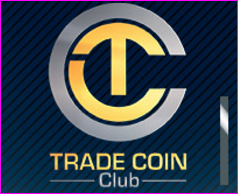Trade Coin Club Review — Legit Company or Big Scam? Find Out Here…

Welcome to my Trade Coin Club Review!
There has been some buzz about this company lately, so it’s time for another review! As I always say, the best way to make sure you are joining the right company is to do lots of research before signing up. The last thing you want to do is invest your money in a company that collapses just a few short months later. My review will provide you with information on the company, the products, and the compensation plan. So let’s get started!
Trade Coin Club Review — The Company
First things first, I couldn’t find any real information on the company website about who owns or operates Trade Coin Club. When I visited the website, there wasn’t anything more than the company’s logo. I did find out that the Trade Coin Club website domain was registered privately as “tradecoinclub.com” on the 2nd of August, 2016. Also, it seems that the two biggest sources of traffic to the company website are the US and Brazil.
Trade Coin Club Reviews — The Products
Trade Coin Club does not offer any retail products or services. Affiliates who sign up with Trade Coin Club can only market and sell the affiliate membership.
The Trade Coin Club Compensation Plan
Affiliates who want to take part in the Trade Coin Club compensation plan must invest bitcoin that offers a daily ROI:
- Apprentice — Invest 0.25 to 0.99 BTC and receive a 0.35% daily ROI for 8 months
- Trader — Invest 1 to 4.99 BTC and receive a 0.4% daily ROI for 12 months
- Senior Trader — Invest 5 BTC or more and receive a 0.45% daily ROI for 12 months
Every affiliate who participates in the compensation plan is required to pay a 25% fee on ROIs every four months.
Referral Commissions
Affiliates can also earn referral commissions that are paid out through a unilevel compensation structure. This type of compensation structure puts an affiliate at the top of a unilevel team that places every personally sponsored affiliate right under them on level 1.
When a level 1 affiliate brings in new affiliates, they are put on level 2 of the original affiliate’s unilevel team.
When a level 2 affiliate brings in new affiliates, they are put on level 3, etc. Payable unilevel levels are capped by Trade Coin Club at eight.
Affiliates are paid a percentage of the money that is invested by their unilevel team, like so:
- Apprentice — 10% on level 1, 3% on level 2, 2% on level 3 and 1% on level 4
- Trader — 10% on level 1, 3% on level 2, 2% on level 3 and 1% on levels 4 to 6
- Senior Trader — 10% on level 1, 3% on level 2, 2% on level 3 and 1% on levels 4 to 8
Residual Commissions
Trade Coin Club pays residual commissions to its affiliates through a binary compensation structure. This compensation structure puts an affiliate at the top of a binary team that splits into left and right sides. Both sides begin with one position and, once filled, a second level is made by adding another 2 positions under each of the first two, for a total of 4 positions. Additional levels of the binary team are made as they are needed, with each new level holding twice as many positions as the level above it.
When each day ends, new investment volume is counted on both sides of the binary team and the affiliate is paid a percentage of the money that is invested on the weaker side of their binary team. The percentage they receive depends on their Trade Coin Club affiliate rank:
- Apprentice — 8% (capped at 2 BTC a day)
- Trader — 9% (capped at 10 BTC a day)
- Senior Trader — 10% (capped at 15 BTC a day)
Recruitment Commissions
Besides investment volume, every Trade Coin Club affiliate is required to pay a monthly fee:
- Apprentice — 0.015 BTC
- Trader 0.03 BTC
- Senior Trader — 0.045 BTC
These monthly fees are used to pay recruitment commissions through a 3×12 matrix. A 3×12 matrix puts an affiliate at the top of a matrix that has 3 positions right under them. These first 3 positions make up the first level of the matrix and the second level is made by adding another 3 positions under the first three, for a total of 9 positions. Additional levels of the matrix are made the same way, up to 12 levels, and when it is full it holds 797,160 positions.
Matrix positions are filled through direct and indirect recruitment of new affiliates. Every time an affiliate fills a matrix position they are paid 0.003 BTC a month, as long as each affiliate continues to pay their monthly fee. Affiliates can earn a bonus 0.003 BTC commission if a personally sponsored affiliate earns 5x the amount they’ve invested.
Rank Achievement Bonus
Trade Coin Club offers a Rank Achievement Bonus that is determined by the amount of bitcoin an affiliate earns through residual binary commissions a month.
- Trader Level 3 — Earn 10 BTC or more in monthly binary commissions and receive a Montblanc pen
- Trader Level 4 — Earn 50 BTC or more in monthly binary commissions and receive a cruise
- Trader Level 5 — Earn 100 BTC or more in monthly binary commissions and receive an “international Caribbean travel” cruise
- Trader Level 6 — Earn 200 BTC or more in monthly binary commissions and receive a Rolex watch
- Trader Level 7 — Earn 500 BTC or more in monthly binary commissions and receive a Toyota Corolla car
- Trader Level 8 — Earn 750 BTC or more in monthly binary commissions and receive a BMW 320 car
- Trader Level 9 — Earn 1500 BTC or more in monthly binary commissions and receive a BMW Z4 car
- Trader Level 10 — Earn 5000 BTC or more in monthly binary commissions and receive a BMW 18 car
- Trader Level 11 — Earn 10,000 BTC or more in monthly binary commissions and receive a Lamborghini Huracan car
Cost To Join Trade Coin Club
The cost to join Trade Coin Club as an affiliate is based on the amount an affiliate invests:
- Apprentice (0.015 BTC a month) — Invest 0.25 to 0.99 BTC
- Trader (0.03 BTC a month) — Invest 1 to 4.99 BTC
- Senior Trader (0.045 BTC a month) — Invest 5 BTC or more
The moment you have been waiting for in this Trade Coin Club review…
The Verdict On Trade Coin Club
Apparently, the way Trade Coin Club gives out daily ROI’s is based on cryptocurrency trading software:
Our system makes millions of micro transactions every second, making it humanly impossible. Allowing our members to generate profit every second, every hour and every day.
Now I don’t see any evidence of this trading software generating those ROI’s… Plus if that is true, why do they need affiliates investments? Why can’t they just get a loan from the bank and do it themselves… Another red flag is the 25% ROI fee… Honestly, the only income source coming into this company is the investments of other affiliates and that’s how ROI’s are being generated… Newly invested funds paying off existing members while more people recruit…
Chuck Reynolds
Contributor
Alan Zibluk Markethive Founding Member



 Introduced in 2008 as the technology underpinning Bitcoin, a digital currency that is created and held electronically without any central authority, blockchain is a secure digital ledger for any kind of data. It simplifies record keeping and reduces transaction costs.Its range of applications in commerce, finance and potentially politics continues to widen, and that has triggered a debate around how to regulate the tool.
Introduced in 2008 as the technology underpinning Bitcoin, a digital currency that is created and held electronically without any central authority, blockchain is a secure digital ledger for any kind of data. It simplifies record keeping and reduces transaction costs.Its range of applications in commerce, finance and potentially politics continues to widen, and that has triggered a debate around how to regulate the tool.








